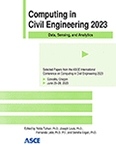Integration of Autonomous Robotics, Indoor Localization Technologies, and IoT Sensing for Real-Time Cloud-Based Indoor Air Quality Monitoring and Visualization
Publication: Computing in Civil Engineering 2023
ABSTRACT
Real-time monitoring of indoor air quality (IAQ) is significant for ensuring occupants’ health and comfort. While smart sensing technologies were used for IAQ monitoring, there is still a gap of quantitatively assessing IAQ and visualizing its interactions with the surrounding physical world. Therefore, this study proposes a novel real-time IAQ monitoring and visualization system. This system specifically integrates an unmanned ground vehicle (UGV), an indoor localization system, and the Internet of Things (IoT). First, an IoT sensing unit was developed to dynamically measure the concentration of different indoor air pollutants. Second, a UGV was configured with the capability of full autonomy for providing mobility to the sensing unit. Third, an indoor localization system was developed using ultra-wideband technology to track the sensing unit. Fourth, a cloud-based web server was created to establish communication for data transmission. Fifth, a 2D visualization interface was generated to visualize the indoor air condition and its interactions with the physical world. The proposed system was validated in a real-world application at the authors’ institution to test its applicability and performance. The proposed system achieved promising performance regarding (1) full navigation autonomy to sense the indoor environment, (2) reliably monitoring and quantifying the indoor air condition, (3) accurately localizing the sensing unit, and (4) intuitively visualizing the IAQ with consideration of both temporal and spatial characteristics of indoor air condition. This study contributes to the body of knowledge by enhancing existing practices of IAQ monitoring using a cost-effective and mobile robotic system and indoor localization technology.
Get full access to this article
View all available purchase options and get full access to this chapter.
REFERENCES
Aguilar, A. J., de la Hoz-Torres, M. L., Martínez-Aires, M., and Ruiz, D. P. (2021). “Monitoring and assessment of indoor environmental conditions after the implementation of COVID-19-based ventilation strategies in an educational building in southern Spain.” Sensors, 21(21), 7223.
Alarifi, A., Al-Salman, A., Alsaleh, M., Alnafessah, A., Al-Hadhrami, S., Al-Ammar, M. A., and Al-Khalifa, H. S. (2016). “Ultra wideband indoor positioning technologies: Analysis and recent advances.” Sensors, 16(5), 707.
Benammar, M., Abdaoui, A., Ahmad, S. H., Touati, F., and Kadri, A. (2018). “A modular IoT platform for real-time indoor air quality monitoring.” Sensors, 18(2), 581.
Ha, Q. P., Metia, S., and Phung, M. D. (2020). “Sensing data fusion for enhanced indoor air quality monitoring.” IEEE Sens. J., 20(8), 4430–4441.
Hu, X., and Assaad, R. H. (2023). “Cloud-Enabled Indoor Thermal Comfort Assessment and Visualization Using Digital Twins, IoT, Robotics, and Indoor Positioning Technology”. In Computing in Civil Engineering 2023.
Jin, M., Liu, S., Schiavon, S., and Spanos, C. (2018). “Automated mobile sensing: Towards high-granularity agile indoor environmental quality monitoring.” Build Environ., 127, 268–276.
Mohammadi, M., Assaad, R. H., and Chang, A. (2023). “An Intelligent IoT Device for Real-Time Cloud-Based Tracking of the Terms of Service in Smart Cities”. In Computing in Civil Engineering 2023.
Neumann, P. P., Hirschberger, P., Baurzhan, Z., Tiebe, C., Hofmann, M., Hüllmann, D., and Bartholmai, M. (2019). “Indoor air quality monitoring using flying nanobots: Design and experimental study”. In Int. Symp. on Olfaction and Electronic Nose, Fukuoka, Japan.
Oh, T., Kim, M., Lim, J., Kang, O., Vidya Shetty, K., SankaraRao, B., and Kim, J. T. (2012). “A real-time monitoring and assessment method for calculation of total amounts of indoor air pollutants emitted in subway stations.” J. Air Waste Manag. Assoc., 62(5), 517–526.
Pamonpol, K., Areerob, T., and Prueksakorn, K. (2020). “Indoor air quality improvement by simple ventilated practice and sansevieria trifasciata.” Atmosphere, 11(3), 271.
Ribino, P., Bonomolo, M., Lodato, C., and Vitale, G. (2021). “A humanoid social robot based approach for indoor environment quality monitoring and well-being improvement.” Int. J. Soc. Robot., 13, 277–296.
Tran, T. V., Dang, N. T., and Chung, W. Y. (2017). “Battery-free smart-sensor system for real-time indoor air quality monitoring”. Sens. Actuators B Chem., 248, 930–939.
USEPA. (2021). “Indoor air quality.” <https://www.epa.gov/report-environment/indoor-air-quality>(March 10 2023).
Woo, J., Rajagopalan, P., Francis, M., and Garnawat, P. (2021). “An indoor environmental quality assessment of office spaces at an urban Australian university.” B. Res. Inf., 49(8), 842–858.
Information & Authors
Information
Published In
History
Published online: Jan 25, 2024
ASCE Technical Topics:
- Air pollution
- Air quality
- Architectural engineering
- Artificial intelligence and machine learning
- Automation and robotics
- Building systems
- Computer networks
- Computer programming
- Computer vision and image processing
- Computing in civil engineering
- Engineering fundamentals
- Environmental engineering
- HVAC
- Indoor environmental quality
- Internet
- Measurement (by type)
- Methodology (by type)
- Pollution
- Sensors and sensing
- Systems engineering
Authors
Metrics & Citations
Metrics
Citations
Download citation
If you have the appropriate software installed, you can download article citation data to the citation manager of your choice. Simply select your manager software from the list below and click Download.
